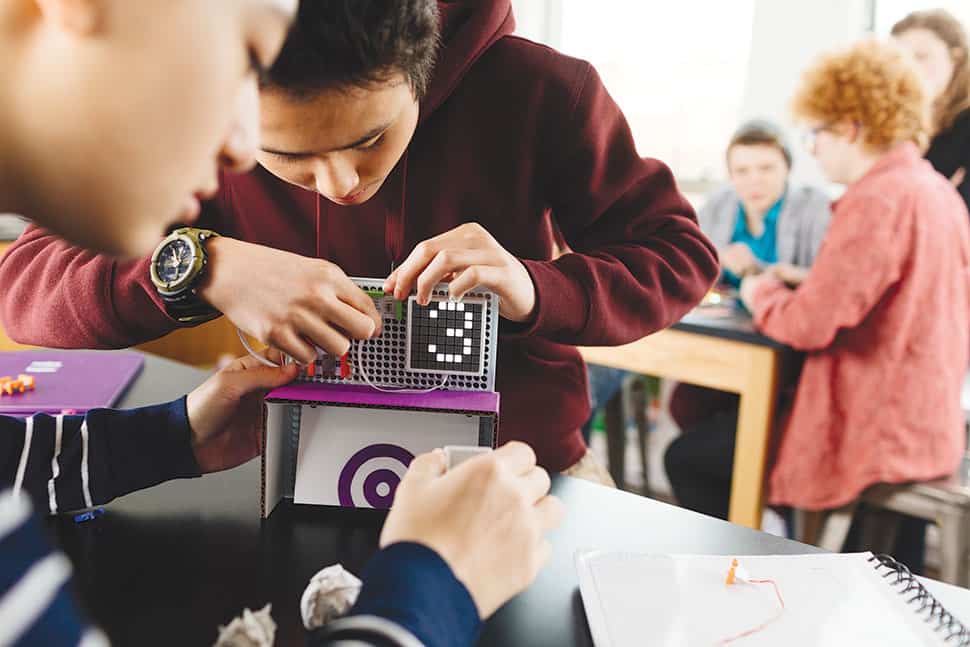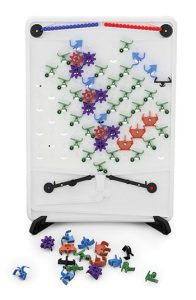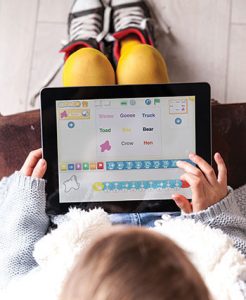
With computing jobs projected to grow two times faster than other fields, coding skills are an increasingly important literacy area. Libraries play a vital role in introducing these skills to their youngest community members. Coding may seem like a daunting subject for those who haven’t studied it, but there are a number of games that introduce computational concepts through play, making it easy and fun to practice computational thinking and problem solving.
littleBits Code Kit
Little Bits has been used in classrooms and makerspaces for years as a platform for building and experimenting with electronics. The Code Kit, released in summer 2017, is its first education-oriented kit to incorporate simple coding into projects. The kit introduces an LED matrix and a “codeBit” to the littleBits collection of electronic building blocks. While coding was possible with littleBits before, with the more advanced Arduino bit, the codeBit is the first that is designed specifically for introductory use by students. The new codeBit is programmable through a web app (compatible with Windows, Mac, and Chromebook operating systems), using a block-based, drag-and-drop language based on Google’s Blockly language.
The Code Kit includes 16 bits, 30 accessories, quick-start guides, and instructions for building and coding four separate games geared toward students in grades 3–8. Online resources include lesson plans and resources for additional projects. Remixing and building on these games is encouraged, and with the wide range of other bits functions available separately and in other kits, there are many possibilities.
Bits are color-coded so each bit type—power, input, and output—is easily identifiable. Small magnets make connections between pieces easy. More advanced bits, such as the cloud and Arduino bits, can be integrated into any kit and allow makers to experiment with technologies that are becoming ubiquitous in everyday devices.
The Code Kit is available for $299.95 through the littleBits website with a 5% discount for educators, and through a variety of educational suppliers. For more information, visit littlebits.cc/products/code-kit.
Turing Tumble
Turing Tumble seems simple: a series of movable pieces guides marbles down an angled game board, with the goal of creating different outputs. Designed, prototyped, and successfully Kickstarted last year by Paul and Alyssa Boswell, both former educators, the game uses these simple actions to demonstrate the most basic inner workings of computers.

Each piece functions as a part of the electrical processes that happen inside computers, with small ramps acting as wires, marbles as electricity, and “bits”—effectively on-off switches that change directions when marbles land on them—acting as variables
and memory storage. Puzzle solutions demonstrate pattern generation and simple mathematical calculations such as multiplication and division. The game is “Turing complete,” which means that, with a large-enough board, the pieces could be used to build a system capable of performing any computing task.
Turing Tumble comes with a booklet of 60 story-based logic puzzles designed for ages 8 and up, which teach and then build upon programming skills as they increase in difficulty. A graphic novel illustrated by one of Paul Boswell’s former computer science students provides a narrative framework for the puzzles, with each solution bringing a stranded space explorer closer to rescue.
Replacement pieces can be purchased online or 3D printed using the CAD files included in the virtual pack. A small community of makers is active on the forum, accessible through the website, sharing 3D printing files and advice as well as puzzle solutions.
Turing Tumble is available directly from the creators through turingtumble.com for $64.95, or through TLC’s SmartTech shop (tlcsmarttech.shop), its library distribution partner, for $59.95. TLC also offers volume discounts for larger orders.
Creating Stories with ScratchJr

User: Kelly Hincks, lower school librarian, Detroit Country Day School, Bloomfield Hills, Michigan
Product: ScratchJr
Description: ScratchJr is a free app, designed for children ages 5–7, that allows kids to program interactive stories and games using a visual coding language.
How do you incorporate ScratchJr into lessons?
For me, ScratchJr blends well with reading comprehension skills. Students create projects to share the main idea and details of a story by creating pages within the project. The first page shares the main idea and the next pages share details from the story to support it. ScratchJr has students learn story elements like character and setting naturally as students code a character to move and choose a background as the setting.
How does ScratchJr serve your library’s and students’ needs?
As a librarian, my goal is to expose students to all forms of literacy. Coding, to me, is another form. The color-coded block language used in the app allows students to easily see each part of their program. To them it is like building a puzzle that will make something move. The ScratchJr website has a wealth of information available to teachers, librarians, and parents.
What are the main benefits?

Allowing children to improve their computational thinking skills is probably the biggest benefit I see. Students have to think in a systematic way when they are coding, and the ScratchJr app allows them to do that. While the language of coding is ever-changing, the process stays the same. Teaching students that process is really the key to all types of learning.
Another benefit is student engagement. Students are eager to participate, and even the most reluctant readers are excited about discussing elements like the main idea of the story when we mix it with coding. Additionally, it gives even the quietest students a voice. Since there is a recording option within the ScratchJr app, students can share their responses without having to do it in front of a large group.
What would you like to see improved or added to this resource?
It is important for us to share this work with parents and other stakeholders. As the app is set up now, a project can easily be saved to the device within the app and emailed, but it has to be opened on a device that has the ScratchJr app. Many parents do not have this app on their personal devices. It would be wonderful if, in the future, the projects could be shared more easily or uploaded to other apps.


